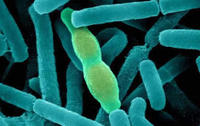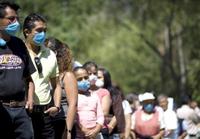-
Secrets of plague unlocked with stunning new imaging techniques
Sandia Labs researchers have developed a super-resolution microscopy technique that is answering long-held questions about exactly how and why a cell’s defenses fail against some invaders, such as plague, while successfully fending off others like E.coli
-
-
HHS awards SIGA Technologies smallpox contract worth up to $2.8 billion
New York-based SIGA Technologies has signed a 5-year, $433 million contract with the U.S. Department of Health and Human Services (HHS) to deliver two million courses of the company’s smallpox antiviral, ST-246, to the Strategic National Stockpile; the contract includes options that would raise the contract’s total value to approximately $2.8 billion if these options are fully exercised
-
-
Kansas House cuts troubled agency's role in funding of bio lab
DHS has chosen Kansas State University (KSU) in Manhattan, Kansas, as the location for the new, $650 million Level 4 BioLab, which will replace the aging lab on Plum Island, New York; the federal laboratory will be the U.S. premier facility for research into countering possible bioterrorism attacks and threats to the nation’s food supply; the Kansas Bioscience Authority (KBA) was supposed to handle the issuing of $105 million in bonds to develop the lab, but the KBA’s chief executive has recently resigned under a cloud, and the agency’s business practices are now being investigated the Johnson County District Attorney; the Kansas House voted to cut the KBA out of handling the bond issue; “We didn’t want any kind of hint of a problem,” said one House member
-
-
New insect repellant may be thousands of times stronger than DEET
The Bill & Melinda Gates Foundation has been supporting a major interdisciplinary research project to develop new ways to control the spread of malaria by disrupting a mosquito’s sense of smell; as part of the project, Vanderbilt University researchers developed an insect repellant which is not only thousands of times more effective than DEET — the active ingredient in most commercial mosquito repellants — but also works against all types of insects, including flies, moths, and ants
-
-
Researchers use app to map spread of infectious diseases
Researchers in the United Kingdom are using cell phones to map how infectious diseases are spread to help tailor public health policies during a mass outbreak; researchers developed a special app, called FluPhone, for mobile phones that gathered medical data from the user as well as information on how they interacted with other people; the app provides a scientific method for measuring the social activity of an entire population in real-time; FluPhone app can also be used to run simulations on how a disease would actually spread
-
-
Foot-and-mouth disease control measures could be reduced
A new study of foot-and-mouth disease shows that cattle afflicted with the virus are only infectious for a brief window of time — about half as long as previously thought; this finding suggests that the controversial control measures used to halt the disease’s spread, such as killing large numbers of livestock, could be reduced
-
-
A "whole-system redesign" of U.S. agriculture
Transformative changes in markets, policy, and science, rather than just incremental changes in farming practices and technology, will be critical if the United States is to achieve long-term sustainability in agriculture, according to a nationwide team of agriculturists that includes a University of California, Davis, animal scientist
-
-
U.S. agriculture escaped impacts of global warming -- for now

Global warming is likely already taking a toll on world wheat and corn production, according to a new study led by Stanford University researchers, but the United States, Canada and northern Mexico have largely escaped the trend; the researchers found that global wheat production was 5.5 percent lower than it would have been had the climate remained stable, and global corn production was lower by almost 4 percent; Global rice and soybean production were not significantly affected
-
-
Asthma cases rising, researchers do not know why

Despite efforts in the United States to improve air quality, recent research shows that asthma rates are on the rise, leaving public health officials baffled; on Tuesday, the U.S. Centers for Disease Control and Prevention (CDC) announced that from 2001 to 2009 an additional 4.3 million people had been diagnosed with asthma; in 2001, 7.3 percent of the United States suffered from asthma, but in 2009 that number grew to 8.2 percent; black children saw the largest increase in asthma rates, growing nearly 50 percent over the last decade
-
-
Risk of agroterrorism growing
The United States imports so much of its food and food ingredients from other countries, that terrorists have many more opportunities to harm Americans and damage the U.S. economy; a high FDA official said that increased U.S. attention to the issue and questions over whether hostile actors have the technical capacity to mount such an attack notwithstanding, the likelihood of being poisoned by intentionally contaminated food is growing
-
-
Magnetic "nanobeads" detect chemical and biological agents
Researchers at Oregon State University have found a way to use magnetic “nanobeads” to help detect chemical and biological agents, with possible applications in everything from bioterrorism to medical diagnostics, environmental monitoring, or even water and food safety; rapid detection of chemical toxins used in bioterrorism would be possible, including such concerns as anthrax, ricin or smallpox, where immediate, accurate and highly sensitive tests would be needed
-
-
Social media helps CDC track Playboy Mansion disease outbreak

Thanks to social media outlets, medical researchers are one step closer to discovering why more than 120 people were infected with a mysterious illness following a 3 February party at the Playboy Mansion; investigators suspect that the bacteria that causes Legionnaires’ disease may have been the source of the outbreak after its presence was discovered in the grotto of the Playboy Mansion; officials used online tools like Twitter, Facebook, and online polling to help track the disease outbreak; these tools were particularly helpful because they allowed officials to quickly identify the outbreak, communicate quickly with conference goers who came from thirty countries, and to issue instructions for the infected
-
-
California schools struggle to vaccinate millions against whooping cough
After experiencing its worst whooping cough outbreak in more than six decades, California is taking extra precautions to ensure that children are vaccinated against the preventable disease; California lawmakers mandated that all children entering the seventh grade and up must have a whooping cough booster vaccine; but parents and school districts are still scrambling to get children vaccinated before the Fall when students will be prohibited from entering a classroom without it; nearly three million students must be vaccinated making it a logistical nightmare for schools to process paperwork; in 2010, there were than 7,800 cases of whooping cough and the disease claimed the lives of ten children
-
-
Promising anthrax treatment study results

Researchers find that a multi-agent prophylaxis which is initiated within twenty-four hours after the infection, prevented the development of fatal anthrax respiratory disease; treatment which combines antibiotics with immunization and a protective antigen-based vaccine offered long-term immunity against the disease
-
-
Information sharing seen as public health "game changer"

Public health officials are pushing for the creation of shared databases that contain electronic health records (EHRs) to help combat infectious diseases and stop epidemics; a CDC official pointed to the positive impact that electronic health information exchanges (HIE) have on public health; during the 2003 SARS outbreak, Milwaukee helped establish a four-state network that automatically detected new cases of SARS based on electronic reports from local hospital emergency rooms; manual reporting of test results is a slow process, but with the use of electronic reporting public health officials can now quickly identify epidemics and pandemics as they occur
-
More headlines
The long view
Ransomware Attacks: Death Threats, Endangered Patients and Millions of Dollars in Damages
A ransomware attack on Change Healthcare, a company that processes 15 billion health care transactions annually and deals with 1 in 3 patient records in the United States, is continuing to cause massive disruptions nearly three weeks later. The incident, which started on February 21, has been called the “most significant cyberattack on the U.S. health care system” by the American Hospital Association. It is just the latest example of an increasing trend.
